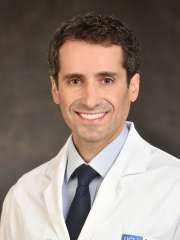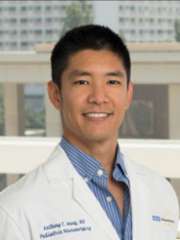Moyamoya Disease
Find your care
Our expert team is skilled at treating complex cerebrovascular conditions and providing the finest and most comprehensive patient care. For help finding a neurosurgeon, call .
What is moyamoya disease?
Moyamoya disease is characterized by the blockage of the carotid arteries in the skull. In an attempt to compensate for this blockage, a fine network of blood vessels grows at the base of the brain. The Japanese word moyamoya, which means "puff of smoke," is a nickname used to describe the hazy appearance of this cluster of blood vessels.
Moyamoya disease is very rare. It occurs more commonly in Asian populations, but people of all ethnicities and ages can develop the condition. When it does occur, it is most common in children younger than 10, and among adults in their 40s. The exact cause of moyamoya disease is not yet known, but it does tend to run in some families, indicating a genetic component.
What are the symptoms of moyamoya disease?
Moyamoya disease can cause , bleeding, seizures and cognitive problems in children and adults. The progressive narrowing of the arteries deprives the brain of oxygen. This can result in stroke, mental impairment and muscle weakness.
How is moyamoya disease diagnosed?
At UCLA, we use the most advanced imaging techniques to quickly and accurately diagnose moyamoya disease. Imaging techniques may include:
- Magnetic resonance imaging (MRI) helps locate the regions of the brain being deprived of blood flow.
- Magnetic resonance angiography (MRA) can record the pattern and velocity of blood flow.
- Cerebral angiography is used to best visualize the narrowing or closure at the end of the internal carotid artery, the abnormal tangle of tiny vessels and other related blood vessel formations. This imaging technique is also critical to assess the vessels that might be used to restore blood flow to areas affected by the moyamoya.
How is moyamoya disease treated?
UCLA is one of the nation's leading moyamoya centers. Our cerebrovascular team includes some of the world's best-recognized experts in the disease. As a result, we treat an exceptionally high volume of moyamoya patients.
Surgery for moyamoya disease is designed to reestablish blood flow to the brain using other blood vessels (called microsurgical revascularization). During surgery, we use advanced imaging and blood flow detection techniques to precisely identify donor and target blood vessels for microsurgical revascularization. UCLA offers every option for treatment of moyamoya, including:
- Direct bypass surgery: In this surgery, a healthy blood vessel (typically from the scalp) is sewn directly into a brain artery to provide immediate restoration of blood flow.
- Indirect bypass surgery: In this procedure, the surgeon attaches a blood vessel onto the surface of the brain. As it heals, this donor vessel improves blood supply to the brain. This procedure is used often in children with moyamoya.

Contact us
To schedule an appointment at the UCLA Cerebrovascular Program, please call 310-825-5111 or request a call back for an appointment.

Geoffrey Colby, MD, PhD

Jeremiah Johnson, MD
